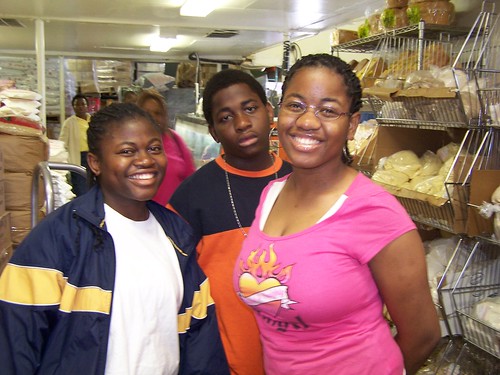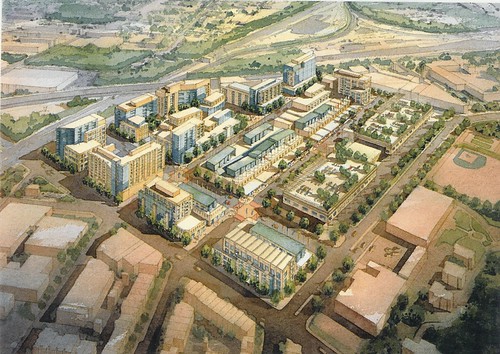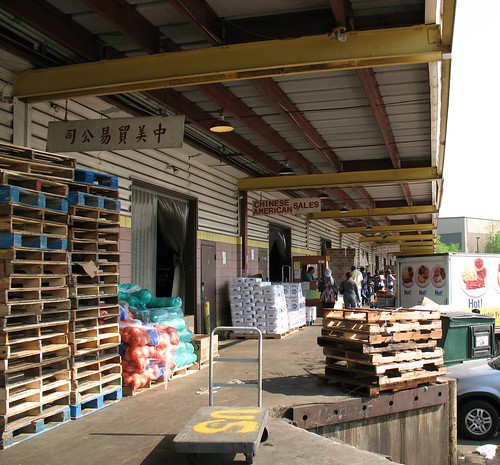Gateway Market Testimony
--------------
This testimony was not presented at last night's hearing, because the Zoning Commission decided to hold a second hearing in about 45 days, to afford more time to ANC5B and ANC6C to be able to better address the project, and to give the applicant more time to reach out to the community. Testimony from everyone but the applicant was continued to the second session. Some of these issues are also covered in this blog entry, "Zoning: Gateway Market Residences," from Frozen Tropics.
I will present this testimony at the July 24th hearing.
--------------
Testimony to the DC Zoning Commission
Case 06-40/Gateway Market
Requesting approval of a consolidated planned unit development (“PUD”) and related map amendment from C-M-1 to C-3-C
Citizens Planning Coalition]
Thank you Chairman Hood and members of the Commission for the opportunity to speak to you today about the proposed PUD and rezoning matter concerning the old U.S. Beef site in the Capital City/Florida Market. The Citizens Planning Coalition is a grassroots organization concerned with civic engagement, land use and transportation planning issues, linked together by a focus on strengthening all aspects of the livability of the great city of Washington, DC. CPC is best known for leading the creation of ward, now area, planning elements in the Comprehensive Land Use Plan, when the first City land use plan was created, after Home Rule and local control of planning and land use decision making shifted to the city government and away from the National Capital Planning Commission, a federal agency.
Case 06-40 illustrates that there can be significant gaps in land use planning efforts when zoning processes are pursued separately from matters that are inextricably intertwined with the request for a zoning change for a particular piece of property, but involve far broader planning, economic development, and public finance matters that are not considered part of the case as heard by the Zoning Commission.
The request for a PUD and map amendment change exists simultaneously with separate proposals for a broad redevelopment of the market.
You must know that the Florida Market is a large area, over 20 acres, many property owners, with more than 100 food-related businesses, employing as many as 1,500 people. The Market District got its start in the 1930s, when Downtown's Center Market closed. Food-related businesses ended up locating near Florida and New York Avenues because that's where the B&O Freight Terminal was located, and most food products were delivered by railcar.
The market sells to both wholesale and retail customers, with a focus on wholesale business. Many of the customers are in turn small businesses such as restaurants and catering firms, who prefer to buy directly from wholesalers, rather than pay delivery charges (which are increasing drastically due to the increase in gasoline prices). One of the market businesses alone does 50% more business than a typical Giant or Safeway supermarket. The Florida Market is big business.
"Reading" the Florida Market
I am presenting to you tonight two signs, one a directory of the businesses that sell retail food products, and another on the history of the Florida Market.
I shop at the Market because the prices are the best in the City, by far, stretching my food dollar. And it's a lot of fun.
With better wayfinding and information systems, more people can be introduced to the Capital City/Florida Market, and appreciate it in the same way that I do.
But these signs make another very important point. The Florida Market district is a commercial district where one project can have a significant and extraordinary impact on other businesses and property owners and it is important for the Zoning Commission to consider this fact in your deliberations of this matter.

Figure 1: A. Litteri, Inc., located on the 500 block of Morse Street NE.

Figure 2: At Obeng International, 300 Morse Street NE.
Urban renewal proposal by the Sang Oh Development group
Separately from Case 06-40, the Sang Oh development group has has proposed an urban renewal project for the Capital City/Florida Market district, not driven so much by market forces but by pecuniary opportunities abetted by political involvement.
Figure 3: A rendering of the land use changes that would result from the original urban renewal proposal put forward by the Sang Oh Development Company, enabled by specially created and lobbied legislation passed by DC City Council in December 2006.
This was done by moving forward a project-specific law, which was passed by the DC City Council in December 2006. This law, calling for the redevelopment of the Capital City/Florida Market and invoking the threat of eminent domain, was created independent of the City's land use planning processes.
The overhang of the redevelopment proposal has negative impacts on the business environment in the market. Typically, when eminent domain is exercised, only the property owners have the right to compensation. Because many of the businesses in the Florida Market operate in buildings that they do not own, the businesses are at the risk of closure without compensation.
Many businesses have relocated, some businesses are opening locations outside of the city to keep their options open, some property owners are not renewing leases, but converting fixed term leases to month-to-month, and prices for space are going up significantly, independently of the economic viability of the space in terms of retail sales potential.
Gateway Market property tax abatement proposal
Separately, there is another bill before City Council calling for a 15 year property tax abatement to assist in developing the Gateway Market project as laid out in Case 06-40.
One could surmise that the Gateway Market project is not viable economically, if a property tax abatement of this magnitude is required. If this is the case, then rezoning the land from C-M-1 to C-3-C is likely not justified either.
The zoning changes requested should be considered in the context of the redevelopment and tax abatement proposals, not separately and independently
We argue that the redevelopment initiative calling for the use of eminent domain and the tax abatement request should be considered along with the PUD and map amendment requests in Case 06-40.
We think this is a reasonable request given that the Sang Oh Development Company marketing materials imply the link between the rezoning called for in case 06-40, and significant changes in the Capital City/Florida Market district as evidenced in the sign posted on the site at 4th Street and Florida Avenue NE.
Figure 4: The sign says "Pretty soon, you won't recognize the place. Promise." It does not state that zoning changes are required to make this happen, as well as a 15 year free ride on property taxes. Flickr photo by Elise Bernard.
Yet, substantive information on these matters are not likely to be part of the testimony and submissions offered by the proponents of the Gateway Market rezoning.
Previous land use planning efforts did not call for the mixing of residential with the industrial and other commercial uses in the Capital City/Florida Market
Changing the land use of this site, while leveraging access to the New York Avenue Metro station, is counter to most of the stated land use policies for the Capital City/Florida Market.
In 2005, the Office of Planning released a two year study of industrial land use planning issues, which called _not for zoning changes in the market allowing for residential use__ but for maintenance and intensification of industrial, business-to-consumer, and business-to-business uses. (Industrial Land Use Study)
In 2004 and 2005, the Office of Planning conducted an economic planning study of Cluster 23, which includes the Capital City/Florida Market district. This study also called for the maintenance and strengthening of the industrial-food district character of the Capital City/Florida Market district. (The Northeast Gateway Revitalization Strategy and Implementation Plan)
It proposed extending the character of the retail marketplace along food festival and marketplace lines, and by adding more food related businesses including specialty stores, bakeries, and restaurants, by including vocational training opportunities, such as a culinary school, given the importance of the hospitality industry in a city with more than 17 million tourist visits each year, and entrepreneurial development opportunities, such as a commercial kitchen able to be rented by small catering firms and food processors.
The NoMA plan, released in 2006, also indicated that the food-related industrial and retail character of the Capital City/Florida Market should be retained, although the Market district is located just outside of the geographic boundaries of that planning study. (NoMA Vision Plan and Development Strategy)
Currently, the Office of Planning is engaged in a specific planning effort for the Capital City/Florida Market, including various actors -- all of the property owners, including Gallaudet University, which holds strategic parcels, merchants, and interested citizens. The sentiment is to retain the Market, not to redevelop the Market into something else. For the most part, the Sang Oh interests have not participated in this process, or have mischaracterized this process in various filings, including those submitted to the Zoning Commission, as well as at various public meetings.
However, CPC must admit that the Comprehensive Land Use Plan, passed in 2006, offers conflicting guidance. A review of the Upper Northeast area element finds a number of policies and actions directly relevant to Case 06-40.
Policy UNE-1.1.8 Untapped Economic Development Potential states that new shopping and business opportunities should be developed in the Capital City Market.
Policy UNE-1.1.9 Production, Distribution, and Repair Uses calls for retention of industrial uses, and emphasis of new uses that create jobs for Upper Northeast area residents.
Policy UNE-2.1.2 Capital City Market states that the market should be redeveloped into a regional destination that includes housing, in addition to dining, entertainment, office, hotel, and wholesale food uses.
Office, retail dining, entertainment, and even hotels are complementary uses to the kind of industrial district that the Capital City Market is. Residential housing is not. At least at this time.
However, the language about residential uses to the Market was not created by the Office of Planning staff during the Comprehensive Plan meeting and document draft preparation process and it did not develop out of the extensive public meeting process associated with the redrafting and updating of the Plan.
Instead, this language was added at the behest of City Council, in response to requests put forward by the Sang Oh Development Company. It was a politically-induced request, not one justified by the land use considerations that existed at the time the Comprehensive Plan was revised.
The Citizens Planning Coalition argues that the land use rezoning request in Case 06-40 is premature for a number of reasons:
1. The Florida Market planning process has not finished.
2. Consensus has not been reached on the future of the Florida Market.
3. Adding residential housing to a fundamentally industrial area is at odds with the other land, which remains industrially zoned.
4. Adding residents to an industrial area will create major conflicts in terms of noise, quality of life, mobility and transportation, etc.
5. If the zoning change is approved and the project goes forward, mobility and transportation changes likely necessary for residential use are not likely to be constructed for many years or never, creating further use conflicts.
Furthermore, concerning the addition of housing, which is the most significant change called for by the proponents in Case 06-40--the rezoning of industrial land to a different category in order to allow the insertion of housing in the land uses present in the Florida Market district--the Policy Guidance within the Area Element is suspect because the language was developed separately from the process that created the Comprehensive Plan draft as submitted to City Council.
Rather, this language was inserted into the Upper Northeast Area Element as a part of the political process involved in approving the Comprehensive Plan. This process, for the most part, was not a public one, and involved a great deal of back room negotiating and favoritism.
While the Washington Gateway project is "mixed use," you could call it "clean mixed use," involving involves office, retail, and hotel in addition to housing. Not industrial land. The Gateway Market project calls for mixing residential uses with food manufacturing, warehousing, and food distribution activities in immediate proximity.
Figure 5: A typical loading dock at the Capital City/Florida Market. Flickr photo by Mr. T in Washington.
There is a logical reason for the exclusion of typical residential housing (not live-work or artist space) in industrial zones. It has the potential to create significant nuisances and conflicts between residents pursuing residential quality of life goals and businesses engaging in building use practices and transportation demands that if fully executed, create what most residents would consider nuisances.
In fact, the Upper Northeast Area Element calls discusses Truck Traffic in Policy UNE.1.1.12 and Buffering industrial uses from residential uses in Policy UNE-1.1.11.
Yet, if the Zoning Commission grants the zoning change to C-3-C as requested, it will create conflicts between commercial and residential property users, without the ability to buffer the respective interests, because the Gateway Market proposal instead puts the costs of addressing those conflicts on other parties.
We aver that the Zoning Commission cannot look at Gateway Market rezoning request without considering the reality of what it proposes--the mixing of residential in an industrial zoning district.
Conclusion
Because:
1. The Florida Market planning process is not finished;
2. There is not consensus on whether or not housing should be added to the Florida Market district at this time;
3. That conflicts between industrial users and residential users would be created by the rezoning of the property to C-3-C from C-M-1;
4. That there is no mitigation plan to reduce the likelihood of these conflicts between users;
5. That pending urban redevelopment proposals threaten to change the market significantly and this rezoning will accelerate that threat;
6. That the project is possibly not economically viable, otherwise it wouldn't have requested a 15 year abatement of property taxes
Therefore, the Citizens Planning Coalition requests that the Zoning Commission not rezone the parcels at issue in Case 06-40 from C-M-1 to C-3-C.
Thank you.

Figure 6: a child clutching a mango at the Florida Market
Labels: civic engagement, food-agriculture-markets, sustainable land use and resource planning, urban revitalization, zoning



0 Comments:
Post a Comment
<< Home